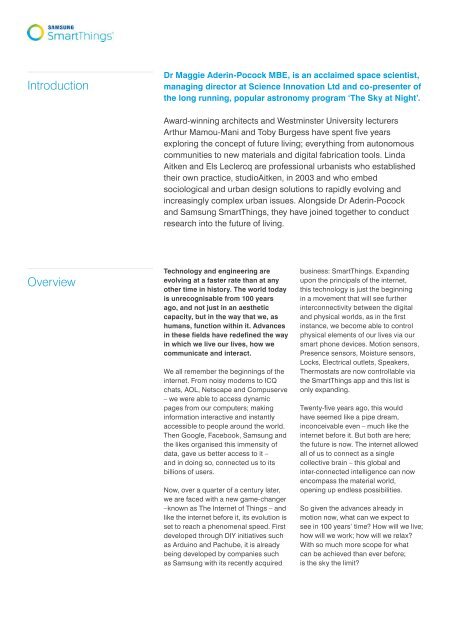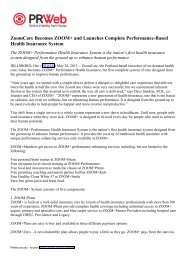Future Living Report
future-living-report
future-living-report
Create successful ePaper yourself
Turn your PDF publications into a flip-book with our unique Google optimized e-Paper software.
Introduction<br />
Dr Maggie Aderin-Pocock MBE, is an acclaimed space scientist,<br />
managing director at Science Innovation Ltd and co-presenter of<br />
the long running, popular astronomy program ‘The Sky at Night’.<br />
Award-winning architects and Westminster University lecturers<br />
Arthur Mamou-Mani and Toby Burgess have spent five years<br />
exploring the concept of future living; everything from autonomous<br />
communities to new materials and digital fabrication tools. Linda<br />
Aitken and Els Leclercq are professional urbanists who established<br />
their own practice, studioAitken, in 2003 and who embed<br />
sociological and urban design solutions to rapidly evolving and<br />
increasingly complex urban issues. Alongside Dr Aderin-Pocock<br />
and Samsung SmartThings, they have joined together to conduct<br />
research into the future of living.<br />
Overview<br />
Technology and engineering are<br />
evolving at a faster rate than at any<br />
other time in history. The world today<br />
is unrecognisable from 100 years<br />
ago, and not just in an aesthetic<br />
capacity, but in the way that we, as<br />
humans, function within it. Advances<br />
in these fields have redefined the way<br />
in which we live our lives, how we<br />
communicate and interact.<br />
We all remember the beginnings of the<br />
internet. From noisy modems to ICQ<br />
chats, AOL, Netscape and Compuserve<br />
– we were able to access dynamic<br />
pages from our computers; making<br />
information interactive and instantly<br />
accessible to people around the world.<br />
Then Google, Facebook, Samsung and<br />
the likes organised this immensity of<br />
data, gave us better access to it –<br />
and in doing so, connected us to its<br />
billions of users.<br />
Now, over a quarter of a century later,<br />
we are faced with a new game-changer<br />
–known as The Internet of Things – and<br />
like the internet before it, its evolution is<br />
set to reach a phenomenal speed. First<br />
developed through DIY initiatives such<br />
as Arduino and Pachube, it is already<br />
being developed by companies such<br />
as Samsung with its recently acquired<br />
business: SmartThings. Expanding<br />
upon the principals of the internet,<br />
this technology is just the beginning<br />
in a movement that will see further<br />
interconnectivity between the digital<br />
and physical worlds, as in the first<br />
instance, we become able to control<br />
physical elements of our lives via our<br />
smart phone devices. Motion sensors,<br />
Presence sensors, Moisture sensors,<br />
Locks, Electrical outlets, Speakers,<br />
Thermostats are now controllable via<br />
the SmartThings app and this list is<br />
only expanding.<br />
Twenty-five years ago, this would<br />
have seemed like a pipe dream,<br />
inconceivable even – much like the<br />
internet before it. But both are here;<br />
the future is now. The internet allowed<br />
all of us to connect as a single<br />
collective brain – this global and<br />
inter-connected intelligence can now<br />
encompass the material world,<br />
opening up endless possibilities.<br />
So given the advances already in<br />
motion now, what can we expect to<br />
see in 100 years’ time? How will we live;<br />
how will we work; how will we relax?<br />
With so much more scope for what<br />
can be achieved than ever before;<br />
is the sky the limit?








